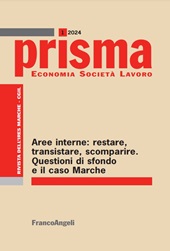Innovare i servizi di welfare nel cratere sisma 2016
P. 102-111
Il cratere del post sisma 2016 è una vasta area geografica provata dalle conseguenze del terremoto e alle prese con le problematiche preesistenti tipiche delle aree interne del nostro Paese. Qui i servizi di welfare locale faticano a dare risposte adeguate ai bisogni sociali emergenti e sempre più pressanti delle comunità. In questi luoghi, inoltre, la carenza di una popolazione giovanile radicata e pronta ad attivarsi ha costituito un disincentivo al rafforzamento dei servizi e del tessuto sociale ed economico locale oltre che alla costruzione di politiche mirate per il contrasto alla povertà giovanile e femminile. I dati sulla popolazione NEET raccontano uno spaccato non ancora adeguatamente intercettato su cui è necessario intervenire.
Per rispondere a questi problemi, il ricorso a pratiche collaborative tra pubblico e privato sociale formale e informale può costituire un'opportunità nuova ma ancora non sufficientemente esplorata per via di problematiche contingenti e/o strutturali. In questo articolo vengono quindi descritte le attività che ActionAid svolge in questa area, fin dai primi giorni dopo il ter-remoto, per rispondere alle criticità con l'attivazione di pratiche collaborative con amministrazioni, comunità e attori del privato sociale. Attraverso la presentazione del progetto RETI, vengono approfondite le attività svolte da Actionaid per sostenere la partecipazione e il protagonismo delle persone e per costruire forme di cooperazione comunitaria finalizzate a meglio contrastare le condizioni di vulnerabilità presenti anche attraverso gli strumenti della coprogettazione dei servizi. [Testo dell'editore]
The 2016 post-earthquake area is a large geographical region still affected by the consequences of the earthquake and grappling with the pre-existing problems typical of the inner Italian's areas. Here, local welfare services have difficulty providing adequate responses to the emerging and increasingly pressing social needs of communities. In these places, moreover, the lack of a rooted young population ready to become active has been a disincentive to strengthening services and the local social and economic fabric as well as to design targeted policies to prevent and counteract youth and female poverty. The data on the NEET population show a picture not yet adequately intercepted on which it is urgent to take tailored actions.
To respond to these problems, the use of collaborative practices between the public and the formal and informal social private sector may constitute a new opportunity that, however, is still insufficiently explored in the inner crater areas due to contingent and/or structural problems. This article therefore describes the activities that ActionAid has been carrying out in this area since the first days after the earthquake to respond to these critical issues. The presentation of the RETI project allows us to explore in depth the set of interventions implemented by ActionAid that aim to support people's participation and protagonism and to build forms of community cooperation also through service co-design practices with local stakeholders. [Publisher's text]
Fa parte di
Prisma : economia, società, lavoro : 1, 2024-
Articoli dello stesso fascicolo (disponibili singolarmente)
-
Informazioni
Codice DOI: 10.3280/PRI2024-001007
ISSN: 2036-5063
PAROLE CHIAVE
- Welfare di comunità, NEET, innovazione sociale, empowerment giovanile, terremoto 2016
- Community welfare, NEET, social innovation, youth empowerment, 2016 earthquake


